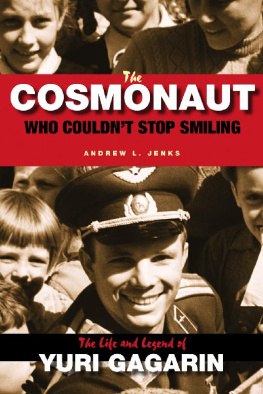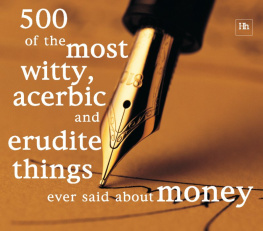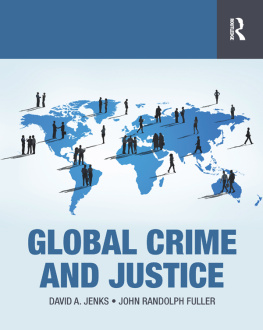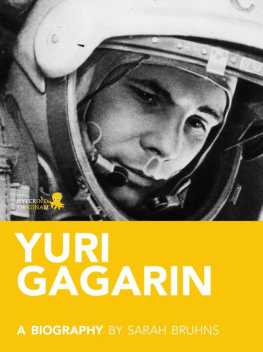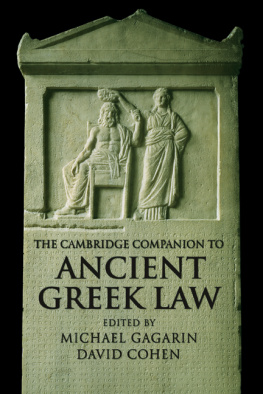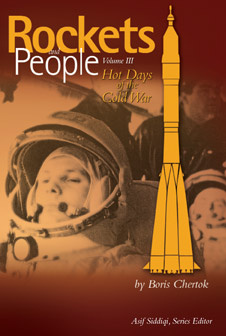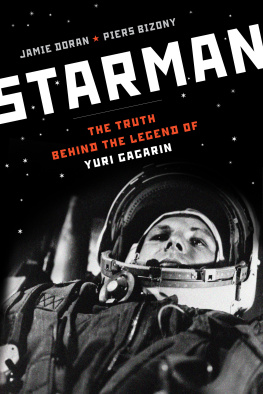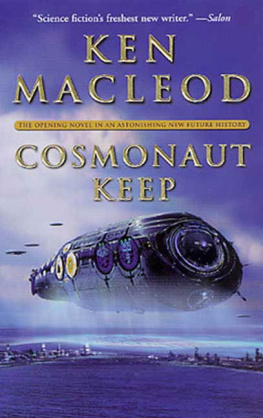Jenks - The Cosmonaut Who Couldn’t Stop Smiling: The Life and Legend of Yuri Gagarin
Here you can read online Jenks - The Cosmonaut Who Couldn’t Stop Smiling: The Life and Legend of Yuri Gagarin full text of the book (entire story) in english for free. Download pdf and epub, get meaning, cover and reviews about this ebook. City: DeKalb, Illinois, year: 2012, publisher: Northern Illinois University Press, genre: Politics. Description of the work, (preface) as well as reviews are available. Best literature library LitArk.com created for fans of good reading and offers a wide selection of genres:
Romance novel
Science fiction
Adventure
Detective
Science
History
Home and family
Prose
Art
Politics
Computer
Non-fiction
Religion
Business
Children
Humor
Choose a favorite category and find really read worthwhile books. Enjoy immersion in the world of imagination, feel the emotions of the characters or learn something new for yourself, make an fascinating discovery.
The Cosmonaut Who Couldn’t Stop Smiling: The Life and Legend of Yuri Gagarin: summary, description and annotation
We offer to read an annotation, description, summary or preface (depends on what the author of the book "The Cosmonaut Who Couldn’t Stop Smiling: The Life and Legend of Yuri Gagarin" wrote himself). If you haven't found the necessary information about the book — write in the comments, we will try to find it.
Jenks: author's other books
Who wrote The Cosmonaut Who Couldn’t Stop Smiling: The Life and Legend of Yuri Gagarin? Find out the surname, the name of the author of the book and a list of all author's works by series.
The Cosmonaut Who Couldn’t Stop Smiling: The Life and Legend of Yuri Gagarin — read online for free the complete book (whole text) full work
Below is the text of the book, divided by pages. System saving the place of the last page read, allows you to conveniently read the book "The Cosmonaut Who Couldn’t Stop Smiling: The Life and Legend of Yuri Gagarin" online for free, without having to search again every time where you left off. Put a bookmark, and you can go to the page where you finished reading at any time.
Font size:
Interval:
Bookmark:

2012 by Northern Illinois University Press
Published by the Northern Illinois University Press, DeKalb, Illinois 60115
Manufactured in the United States using acid-free paper.
All Rights Reserved
Design by Julia Fauci
Figures 1 and 24 are courtesy of the Powerhouse Museum, Sydney, and figures 11 and 14 are from RGAE (Rossiiskii gosudarstvennyi arkhiv ekonomii). All other pictures are taken either by the author or from his own archive.
Library of Congress Cataloging-in-Publication Data
Jenks, Andrew L.
The cosmonaut who couldnt stop smiling : the life and legend of Yuri Gagarin / Andrew L. Jenks.
p. cm.
Includes bibliographical references and index.
ISBN 978-0-87580-447-7 (cloth-bound: alkaline paper) ISBN 978-1-60909-052-4 (electronic)
1. Gagarin, Yuri Alekseyevich, 19341968. 2. AstronautsSoviet Union. 3. Soviet UnionCivilization. I. Title.
TL789.85.G3J46 2012
629.450092dc23
[B] 2011038318
CONTENTS
Yuri Gagarin and the Many Faces of Modern Russia
A Victors Congress Baby
The Industrial Boys
The Chief Designer
The Flight that Launched a Thousand Rumors
Exegesis
Homo Sovieticus
Sacred Lies, Profane Truths
Landscapes of Russianness, 19912011
Given the funding crisis in California higher education in 2011, it seems hard to believe that there was a time when my institution would provide time and resources to fund a project such as this. But its true. California State University, Long Beach, paid for my trip to Russia in 2007in which I did much of the research for this bookand then offered me time off from teaching duties to finish the manuscript.
I am grateful to the Powerhouse Museum, Sydney, which allowed me to use two of its Valentin Shkolny photographs of Gagarin, and to Francis French, who put me in contact with the museum. My colleague and friend at Niagara University, Brian Bennett, gave me many of the Gagarin photographs that appear in this book. Gurbir Singh allowed me to use his fine unpublished manuscript on Yuri Gagarins trip to Manchester. The published version, just out, is Gurbir Singh, Yuri Gagarin in London and Manchester: A Smile that Changed the World? (Manchester: Astrotalkuk Publications, 2011).
A number of colleagues invited me to their institutions to present my research on Gagarin: my good friend Steve Barnes at George Mason University, Amir Weiner at Stanford University, Steven Norris at Miami University of Ohio, Catriona Kelly at Cambridge University, and Clint Walker at the University of Montana. Slava Gerovitch provided invaluable tips on archival sources in Moscow. Donald Raleigh helped me find contacts for my stay in Saratov in the summer of 2007. Velikhan Mirzekhanov, Alexander Novikov, and Mikhail Kovalev made my stay in Saratov intellectually productive. Aleksandra Rossoshanskaia opened up the resources of the Peoples Gagarin Museum in Saratov to me, as did Maria Stepanova, director of the Unified Yuri Gagarin Memorial Museum in the city of Gagarin. Vladislav Zubok gave me the amazing opportunity to meet colleagues from around the former Soviet Union on the spectacular Black Sea coast for the 2009 conference The Teaching of Russias Cultural Legacy in a Global Context. I attempted a brief presentation on Gagarin in Russian in between seminars, wine tastings, sightseeing, and sea bathing. I am especially grateful to NASA Chief Historian Bill Barry, who allowed me to speak at NASA headquarters with a group of distinguished historians at the April 2011 conference, 1961/1981: Key Moments in Human Spaceflight. While Bill introduced me to many members of the space history community, he also provided incisive and detailed criticism that forced me to change many of my interpretations of the Soviet space program and the history of space exploration. Many thanks also to the anonymous reviewers of this manuscriptand to Alex Schwartz and Amy Farranto at Northern Illinois University Press, who were models of professionalism. The mistakes, of course, are all mine. Parts of chapter 8 appeared in my essay, The Sincere Deceiver: Yuri Gagarin and the Search for a Higher Truth, in Into the Cosmos: Space Exploration and Soviet Culture , ed. Asif Siddiqi and James T. Andrews (Pittsburgh: University of Pittsburgh Press, 2011). Parts of chapter 7 appeared in my essay, Conquering Space: The Cult of Yuri Gagarin, in Soviet and Post-Soviet Identities , ed. Catriona Kelly and Mark Bassin (Cambridge: Cambridge University Press, 2012).
Finally, this book would not exist except for the forbearance of my wife, Deanna, and my children, Alexander and Elisabeth. They endured my absences and grumpiness with grace, good humor, and only a little whining; and once I was home they generously permitted me to shut the door to my home office and type away in relative peace and quiet.
YURI GAGARIN AND THE MANY FACES OF MODERN RUSSIA
At 9:07 in the morning of April 12, 1961, a boyish-looking Yuri Gagarin exclaimed, Lets go! and his spacecraft the Vostok (the East) launched him into the cosmos. Why he chose that phrase ( Poekhali! in Russian) is not entirely clear. Some have suggested that the phrase reflected his peasant roots: a Russian peasant would say Poekhali when taking off on a horse. Perhaps more likely, Gagarin uttered a phrase that in English would be closest to Geronimo, spoken by Americans on the cusp of a daring and dangerous maneuver. Whatever the meaning, the twenty-seven-year-old senior lieutenant left earths atmosphere from a secret enclave within the Soviet Union. That world was encased in an elaborate edifice of military secrets, factories, cement barriers, and even entire cities. Barbed wires, censors, armed guards, false identities, mendacious maps, and a myriad of secret signs had hidden Gagarin from outsiders. Not even his parents or closest friends knew what he had been up to. Gagarin, in short, lived in a Do Not Enter realm. On April 12, 1961, he exited that land, a grinning space traveler from the mysterious domain of the Soviet military-industrial complex. He was the first human to enter earths orbitand a Soviet, just like the first man-made satellite Sputnik and the mongrel muttniks Belka, Strelka, and Laika. The capitalist world was aghast; the Soviets rejoiced.
There was no official announcement that the flight was going to take place. True, Soviet officials hinted at a possible flight, sending the capitalist press into a rumor-mongering frenzy. But the Soviets were also acutely aware that the flight could end in disaster. Recent events had provided little cause for comfort. An explosion of an ICBM (Intercontinental Ballistic Missile) rocket on a launchpad less than a year earlier killed more than one hundred of the best and brightest in the Soviet Rocket Forces, including the Marshal of Soviet Rocket Forces I. M. Nedelin. Although the rocket did not have any direct connection to the piloted space effort, there was clearly a repercussive delay on the Vostok program, which involved many of the same design bureaus and engineers. On the day before the flight, engineers discovered that Gagarins seat, with Gagarin in his space suit, was 30 pounds over the acceptable maximum, which they attempted to fix by stripping away parts of the capsules internal apparatus. That action, however, disconnected two critical gauges for pressure and temperature, causing a short circuit that engineers struggled on the eve of the flight to fix.
Equally sobering, many of mans best friends had preceded Gagarin into orbit. Some of these mutts, mostly street dogs, survived the flight, but others20 out of 48 dogs who flew prior to Gagarins flight and 4 of 10 used to test the Vostok capsuleperished ignominiously. So everyone was intensely aware of the possibility of catastrophic failureespecially given mounting political pressures to accelerate the Vostok 3 schedule, primarily because of the stream of news on Project Mercury, the American attempt at manned space flight.
Next pageFont size:
Interval:
Bookmark:
Similar books «The Cosmonaut Who Couldn’t Stop Smiling: The Life and Legend of Yuri Gagarin»
Look at similar books to The Cosmonaut Who Couldn’t Stop Smiling: The Life and Legend of Yuri Gagarin. We have selected literature similar in name and meaning in the hope of providing readers with more options to find new, interesting, not yet read works.
Discussion, reviews of the book The Cosmonaut Who Couldn’t Stop Smiling: The Life and Legend of Yuri Gagarin and just readers' own opinions. Leave your comments, write what you think about the work, its meaning or the main characters. Specify what exactly you liked and what you didn't like, and why you think so.

